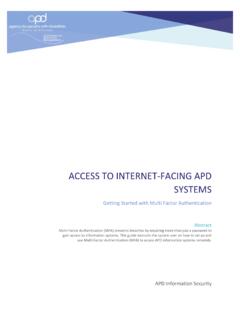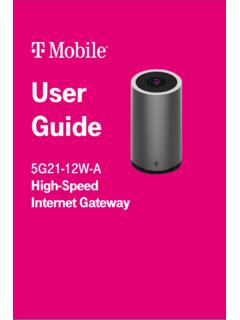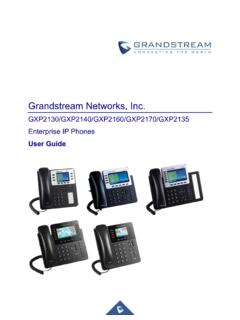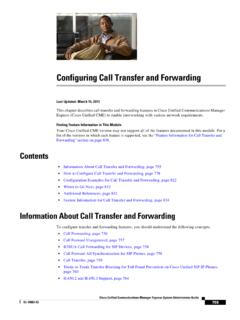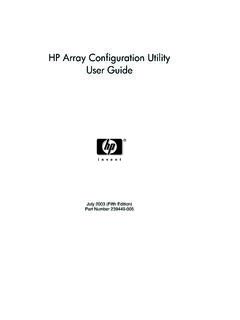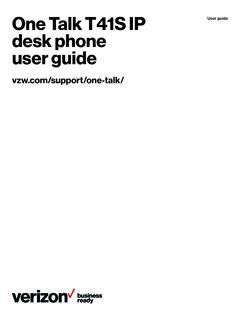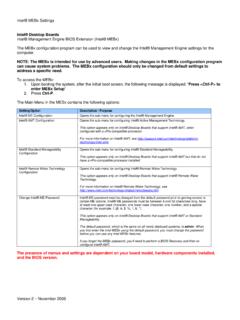Transcription of Configuring Voice VLAN - Cisco
1 CHAPTER 14-1 Catalyst 2960 Switch Software Configuration GuideOL-8603-0414 Configuring Voice VLANThis chapter describes how to configure the Voice VLAN feature on the Catalyst 2960 switch. Voice VLAN is referred to as an auxiliary VLAN in some Catalyst 6500 family switch complete syntax and usage information for the commands used in this chapter, see the command reference for this chapter consists of these sections: Understanding Voice VLAN, page 14-1 Configuring Voice VLAN, page 14-3 Displaying Voice VLAN, page 14-6 Understanding Voice VLANThe Voice VLAN feature enables access ports to carry IP Voice traffic from an IP phone.
2 When the switch is connected to a Cisco 7960 IP Phone, the phone sends Voice traffic with Layer 3 IP precedence and Layer 2 class of service (CoS) values, which are both set to 5 by default. Because the sound quality of an IP phone call can deteriorate if the data is unevenly sent, the switch supports quality of service (QoS) based on IEEE CoS. QoS uses classification and scheduling to send network traffic from the switch in a predictable manner. For more information on QoS, see Chapter 28, Configuring QoS. The Cisco 7960 IP Phone is a configurable device, and you can configure it to forward traffic with an IEEE priority.
3 You can configure the switch to trust or override the traffic priority assigned by a Cisco IP Cisco IP Phone contains an integrated three-port 10/100 switch as shown in Figure 14-1. The ports provide dedicated connections to these devices: Port 1 connects to the switch or other Voice -over-IP (VoIP) device. Port 2 is an internal 10/100 interface that carries the IP Phone traffic. Port 3 (access port) connects to a PC or other device. 14-2 Catalyst 2960 Switch Software Configuration GuideOL-8603-04 Chapter 14 Configuring Voice VLANU nderstanding Voice VLANF igure 14-1 shows one way to connect a Cisco 7960 IP 14-1 Cisco 7960 IP Phone Connected to a SwitchCisco IP Phone Voice TrafficYou can configure an access port with an attached Cisco IP Phone to use one VLAN for Voice traffic and another VLAN for data traffic from a device attached to the phone.
4 You can configure access ports on the switch to send Cisco Discovery Protocol (CDP) packets that instruct an attached phone to send Voice traffic to the switch in any of these ways: In the Voice VLAN tagged with a Layer 2 CoS priority value In the access VLAN tagged with a Layer 2 CoS priority value In the access VLAN, untagged (no Layer 2 CoS priority value)NoteIn all configurations, the Voice traffic carries a Layer 3 IP precedence value (the default is 5 for Voice traffic and 3 for Voice control traffic). Cisco IP Phone Data TrafficThe switch can also process tagged data traffic (traffic in IEEE or IEEE frame types) from the device attached to the access port on the Cisco IP Phone (see Figure 14-1).
5 You can configure Layer 2 access ports on the switch to send CDP packets that instruct the attached phone to configure the phone access port in one of these modes: In trusted mode, all traffic received through the access port on the Cisco IP Phone passes through the phone unchanged. In untrusted mode, all traffic in IEEE or IEEE frames received through the access port on the Cisco IP Phone receive a configured Layer 2 CoS value. The default Layer 2 CoS value is 0. Untrusted mode is the IP Phone 7960PC101351 PhoneASIC 14-3 Catalyst 2960 Switch Software Configuration GuideOL-8603-04 Chapter 14 Configuring Voice VLANC onfiguring Voice VLANNoteUntagged traffic from the device attached to the Cisco IP Phone passes through the phone unchanged, regardless of the trust state of the access port on the Voice VLANT hese sections contain this configuration information.
6 Default Voice VLAN Configuration, page 14-3 Voice VLAN Configuration Guidelines, page 14-3 Configuring a Port Connected to a Cisco 7960 IP Phone, page 14-4 Default Voice VLAN ConfigurationThe Voice VLAN feature is disabled by the Voice VLAN feature is enabled, all untagged traffic is sent according to the default CoS priority of the port. The CoS value is not trusted for IEEE or IEEE tagged VLAN Configuration GuidelinesThese are the Voice VLAN configuration guidelines: You should configure Voice VLAN on switch access ports; Voice VLAN is not supported on trunk ports.
7 NoteVoice VLAN is only supported on access ports and not on trunk ports, even though the configuration is allowed. The Voice VLAN should be present and active on the switch for the IP phone to correctly communicate on the Voice VLAN. Use the show vlan privileged EXEC command to see if the VLAN is present (listed in the display). If the VLAN is not listed, see Chapter 12, Configuring vlans , for information on how to create the Voice VLAN. Before you enable Voice VLAN, we recommend that you enable QoS on the switch by entering the mls qos global configuration command and configure the port trust state to trust by entering the mls qos trust cos interface configuration command.
8 If you use the auto-QoS feature, these settings are automatically configured. For more information, see Chapter 28, Configuring QoS. You must enable CDP on the switch port connected to the Cisco IP Phone to send the configuration to the phone. (CDP is globally enabled by default on all switch interfaces.) The Port Fast feature is automatically enabled when Voice VLAN is configured. When you disable Voice VLAN, the Port Fast feature is not automatically disabled. If the Cisco IP Phone and a device attached to the phone are in the same VLAN, they must be in the same IP subnet.
9 These conditions indicate that they are in the same VLAN: They both use IEEE or untagged frames. 14-4 Catalyst 2960 Switch Software Configuration GuideOL-8603-04 Chapter 14 Configuring Voice VLANC onfiguring Voice VLAN The Cisco IP Phone uses IEEE frames, and the device uses untagged frames. The Cisco IP Phone uses untagged frames, and the device uses IEEE frames. The Cisco IP Phone uses IEEE frames, and the Voice VLAN is the same as the access VLAN. The Cisco IP Phone and a device attached to the phone cannot communicate if they are in the same VLAN and subnet but use different frame types because traffic in the same subnet is not routed (routing would eliminate the frame type difference).
10 You cannot configure static secure MAC addresses in the Voice VLAN. Voice VLAN ports can also be these port types: Dynamic access port. See the Configuring Dynamic-Access Ports on VMPS Clients section on page 12-26 for more information. IEEE authenticated port. See the Configuring IEEE Authentication section on page 9-22 for more information. NoteIf you enable IEEE on an access port on which a Voice VLAN is configured and to which a Cisco IP Phone is connected, the phone loses connectivity to the switch for up to 30 seconds. Protected port. See the Configuring Protected Ports section on page 19-5 for more information.










